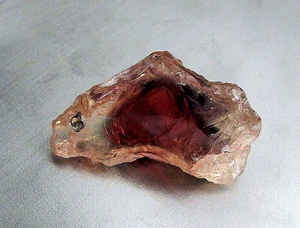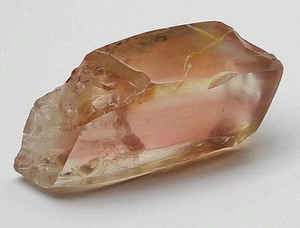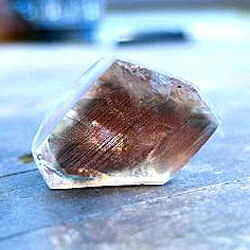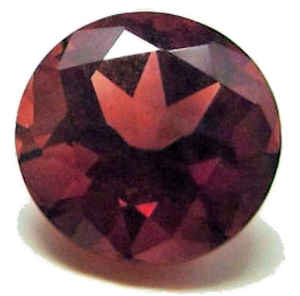Oregon State Gemstone
Oregon Sunstone

(Plagioclase Feldspar)
Adopted on August 4, 1987.
The 1987 Legislature designated the Oregon sunstone, (Plagioclase Feldspar,) as the official state gemstone. It was adopted on August 4, 1987. Uncommon in its composition, clarity, and colors, it is a large, brightly colored transparent gem in the feldspar family occur in Lake and Harney Counties where they are dug from the soil and the underlying lava flows.
Oregon Sunstone: Oregon Gemstone Stone

The terms "sunstone" and "heliolite" (from Greek helios, meaning sun, and lithos, meaning "stone") have been used for at least two centuries for feldspars exhibiting schiller. The Lake County occurrence was first reported in 1908, and the presence of the schiller effect was the original reason for naming the stones sunstones. For decades, however, the term "sunstone" has been used for these Oregon gem feldspars both with and without schiller.
Sunstone is an ancient gem, in fact sunstones have been discovered in Viking Burial mounds. Sunstone also occurs in Tvedestrand, Norway; near Lake Baikal, Russia; Middletown, PA., and Statesville, NC. Only the Oregon Sunstone has the copper inclusions giving it the unique colors. The Oregon sunstone attracts collectors and miners and has been identified as a boon to tourism and economic development in southeastern Oregon counties. For many years, collectors have prized sunstones from eastern Lake County, near Plush, Oregon, where the US Bureau of Land Management has established a free, public collecting area. Until recently, this was the only known occurrence.
The premier US gem-quality feldspar is the red labradorite, known as sunstone, mined in Oregon. Large quantities of gem-quality labradorite, most of it water-clear, straw yellow, or yellow sunstone, has been produced from deposits in southeastern Oregon for many years. In sunstone, the labradorite contains millions of copper platelets that reflects the light with varying intensities resulting in a golden-red play of color known as schiller. Although the common color of Oregon sunstone is straw-yellow, it also can be pink, peach, red, salmon red-orange, red-green, and blue-green. It also can be bicolored and tricolored in combinations of yellow, red, and green, and a small percentage is di- and tri-chroic.
Oregon sunstones are uncommon in their composition, clarity, and range of colors and occur in sufficient abundance to permit sustained production of faceted gems. These color variations and the shimmer (often called "schiller") are caused by tiny crystals of copper metal contained in varying amounts and sizes within the stones. The darker stones contain larger amounts of copper. The reflective inclusions or red, orange, or green platy crystals give Sunstone its metallic glitter.
In 1988, the availability and quality of sunstone, other than the standard yellow Oregon variety, drastically increased with the discovery of the deposit that was to become the Ponderosa Mine. The vivid-red faceted stones and velvety-red cabochons from this mine set a new world standard for beauty, not just for red sunstone, but for any sun-stone. The opening of the mine also increased the supply of peach, salmon red-orange, red-green, green, blue-green, and bicolored and tricolored in combinations of yellow, red, and green. For the first time ever, there was a continuous US supply of the more desirable colors in most of the calibrated sizes up to several carats needed by the jewelry industry. The largest faceted high-quality red sunstone is over 10 carats. The supply from this and other developed deposits will continue to be adequate for many years into the future.
Two more occurrences in northern and southeastern Harney County have been discovered recently, allowing the mining of more marketable gems, and the geology of the area is favorable for the discovery of more deposits. Except for the BLM public collecting areas, all these producing areas are held by mining claims and are not available for collecting without permission of the claim owners.
Characteristics of the Oregon Sunstone

Sunstone is a plagioclase feldspar, which when viewed from certain directions exhibits a brilliant spangled appearance; this has led to its use as a gemstone. It has been found in Southern Norway, and in some United States localities.
CHEMISTRY: A calcium rich species of plagioclase feldspar, sometimes with copper or hematite inclusions and traces of iron; 32% Albite, 68% Anorthite
CRYSTALLOGRAPHY Monoclinic
REFRACTIVE INDEX 1.560 - 1.572
HARDNESS 6 - 6.5
SPECIFIC GRAVITY 2.69 - 2.72
CLEAVAGE Perfect two directions.
HEAT SENSITIVE No
WEARABILITY Poor
Lore of the Sunstone

Sunstone has a long list of mythical lore
attached to it, but here are some of the highlights. In ancient Greece, Sunstone was used to represent the Sun God, Helios (or Apollo). Ancient Greeks
believed Sunstone invigorated and greatly improved the state of the physical body and the spirit, bringing renewed strength and good health to both.
They also believed it brought abundance, prosperity, and protection - so much so with the latter, that they would adorn their drinking vessels with
this stone in order to prevent poisoning. In India, natives wore Sunstone to protect themselves against any intrusive or negative forces.
Sunstone was used by certain Native American Indian tribes to assist their medicine men in contacting Spirit Guides. Placing the stone in the center
of their medicine wheel, it was believed to assist in harnessing the healing powers of the Sun. It was said that the stone would glow a bright golden
color if successful contact was made. Another "glowing" spot of lore regarding Sunstone is that Pope Clement VII was said to be in possession
of a piece which held within it a glowing spot, one that would actually move across the surface of the stone from east to west in conjunction with
the sun.
In myth, ancient Vikings used what they called a "sunstone" to aid their navigations... perhaps both in life and death, as in fact this Feldspar
type of Sunstone has been discovered in Viking burial mounds and is thought to have been placed there to aid one's journey to Valhalla. Current speculation
is that their navigational "sunstone" may have been the Sunstone we know today, but the double refracting Iceland Spar (a form of Calcite)
is also a possibility, as is the transparent mineral Cordierite which turns from yellow to blue whenever held at right angle to the sun. Either way,
the theory is well thought out, as these stones exhibits the exact property which would be needed to navigate by the position of the sun - the property
of refraction. Refracted light makes it possible to locate the sun during storms, fog, or darkness. So just as certain insects use refraction of light
to find direction, so may have these remarkable ancient mariners..
Oregon PROCLAMATION
WHEREAS: A gemstone known as Oregon Sunstone, a member of the feldspar group of minerals occurs in the southeastern counties of
Oregon; and
WHEREAS: Oregon Sunstones are uncommon in their composition, colors, clarity, and optical properties which enhance their beauty and value as faceted
gems; and
WHEREAS: The collecting, mining, and marketing of these precious gems contributes to tourism and economic development of the high desert country of
southeastern Oregon; and
WHEREAS: The 64th Oregon Legislative Assembly proclaimed the Sunstone as the official Oregon gemstone by adopting House Joint Resolution 4.
NOW,THEREFORE, I, Neil Goldschmidt, Governor of the State of Oregon, hereby proclaim
OREGON SUNSTONE AS THE OFFICIAL STATE GEMSTONE
in Oregon and encourage all citizens to join in this observance.
IN WITNESS WHEREOF, I hereunto set my hand and cause the Great Seal of the State of Oregon to be affixed. Done at the Capitol in the City of Salem
and the State of Oregon, on this day, August 4, in the Year of our Lord, One Thousand Nine Hundred Eighty Seven.
(signed) Neil Goldschmidt, Governor
Oregon HOUSE JOINT RESOLUTION 4
Sponsored by Representatives D.E. Jones, Brogoitti, French, Minnis, Norris, Senator Timms, Representative Van Vliet
Whereas the great and sovereign State of Oregon is the sole domestic producer of gem quality sunstones; and
Whereas these precious gems have outstanding potential to attract mineralogists and gemologists from around the world; and
Whereas the development and marketing of these beautiful gems can contribute to tourism and the economic development of the high desert country of
southeastern Oregon; now, therefore,
Be It Resolved by the Legislative Assembly of the State of Oregon:
That the Oregon sunstone be proclaimed as the official state gemstone.
Adopted by House February 19, 1987
Chief Clerk of House
Speaker of House
Adopted by Senate May 19, 1987
President of Senate
Minerals, & Gems

Gemstone, Minerals, Rocks







